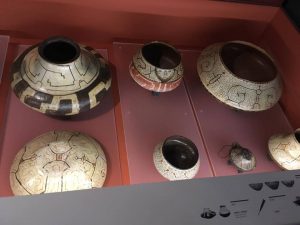In Of Things Said and Unsaid: Power, Archival Silences, and Power in Silence (2006), Rodney G.S. Carter defines archives as places “filled with voices” (216), because archives can be interpreted as compilations of various media and art forms from a specific time period, geographic setting and/or group of people. G.S. Carter elaborates these compilations as “the currency of archives” (216). In the case of the ‘Amazonia’ exhibit curated by Nuno Porto at the ‘Museum of Anthropology’ (MOA), physical relics would be the “currency” (216).
The objects I found most interesting were the Shipibo people’s ceramics and textiles. Their display plaque states the designs inscribed on the crafts were “inspired by the anaconda”, and crafted only by women who passed the practice to each generation (Porto). I am personally intrigued by how the Shipibo incorporated nature into handiwork, as it is likely they used their home, the Amazon as cultural inspiration. Their art exists because of knowledge transmitted within their culture throughout the years (Porto), but most importantly, it can be relevant to Carter’s exploration on different kinds of archival silences.


Photos of the Shipibo artifacts
Taken by Melody Tang
Carter separates silence into “unnatural” and “natural” (228). Whereas “unnatural” happens when a group’s voice is forcibly suppressed by the powerful, “natural” is when they choose silence to actively resist their oppressors (228). With the Shipibo, it is likely they have selected silence due to their past trauma. In the 18th century, when missioners and foreigners made their presence known in the Amazon, the Shipibo allied themselves with other native tribes to drive them away (Porto). Between the late 1800s-1920s, the Shipibo were enslaved and abused by rubber entrepreneurs for intensive production (Porto).
When I attempted further research on the Shipibo and other Amazon tribes, I found little information. Survival International explained presently, the tribes preferred and maintained isolation with outsiders; an estimated 15 uncontacted tribes live in Peruvian Amazon, and the Peru government has passed laws upholding “the tribes’ right to be left alone” (n.p, n.d). MacQueen’s article attributed most of their want for isolation to fear, reporting an instance where an interviewed tribe leader recounted “his parents always talked about how ‘the whites wanted to kill us’” (2016).
Carter observes silence “forces active participation by the readers/listeners” who “must investigate, interrogate, and attempt to understand the contexts that gave rise to the silences” (230). When a group or part of a group finally choose to break their longstanding silence, the impact of their action seems to resonate deeper because it can force individuals to pay closer attention. Survival International reports Amazon tribes are in greater danger because “illegal loggers and miners are invading the forest, and oil and gas concessions cut across more than 70% of Peru’s Amazon region”. Yet instead of remaining silent, some Amazon tribes are starting to reach out to archival institutions to make their presence known. What the Shipibo relics, and the ‘Amazonia’ exhibit seem to exemplify is the starting of a conversation between two groups who though vastly different, can take steps towards acknowledging past tragedies, educating those unaware or wish to learn more, and discussing current issues.
Works Cited:
Carter, Rodney G.S. “Of Things Said and Unsaid: Power, Archival Silences, and Power in Silence.” Archivaria 61: Section on Archives, Space and Power, 2006, pp. 216–233., archivaria.ca/index.php/archivaria/article/view/12541/13687. Accessed 18 January 2018.
Macqueen, Angus. “Why are the lost tribes now emerging from the Amazon?” The Guardian, Guardian News and Media, 20 Feb. 2016, www.theguardian.com/world/2016/feb/21/amazon-lost-tribes-emerge-rainforest-brazil-peru. Accessed 18 January 2018.
“Museum of Anthropology at UBC.” Museum of Anthropology at UBC, The University of British Columbia, moa.ubc.ca/. Accessed 18 January 2018.
Porto, Nuno. “Amazonia: The Rights of Nature.” Museum of Anthropology at UBC, The University of British Columbia, 10 Mar. 2017, moa.ubc.ca/portfolio_page/amazonia/. Accessed 18 January 2018.
“Uncontacted Indians of Peru.” Survival International, www.survivalinternational.org/tribes/isolatedperu. Accessed 18 January 2018.